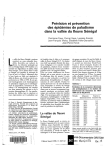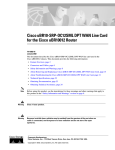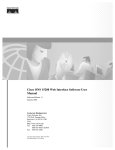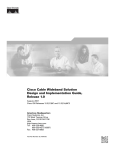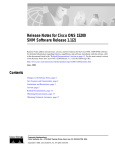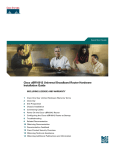Download Cisco Systems 78-11450-03 Network Router User Manual
Transcript
GLOSSARY Symbols 1+1 APS See APS. 10BASE-T 10-Mbps baseband Ethernet specification using two pairs of twisted-pair cabling (Category 3, 4, or 5): one pair for transmitting data and the other for receiving data. 10BASE-T, which is part of the IEEE 802.3 specification, has a distance limit of approximately 328 feet (100 meters) per segment. See also IEEE 802.3 and Ethernet. 100BASE-T 100-Mbps baseband Fast Ethernet specification using UTP wiring. Like the 10BASE-T technology on which it is based, 100BASE-T sends link pulses over the network segment when no traffic is present. However, these link pulses contain more information than those used in 10BASE-T. The 100BASE-T specification is based on the IEEE 802.3 standard. See also 10BASE-T, Fast Ethernet, and IEEE 802.3. 1000BASE-LX/LH 1000-Mbps gigabit Ethernet specification using two strands of multimode or single mode fiber-optic cable per link. To guarantee proper signal recovery, a 1000BASE-LX/LH link cannot exceed 1804 feet (550 meters) in length over multimode fiber or 32,810 feet (10 km) in length over single mode fiber. Based on the IEEE 802.3 standard with reach over single mode fiber extended from 5 km to 10 km. See also 1000BASE-SX, 1000BASE-ZX, Gigabit Ethernet, and IEEE 802.3. 1000BASE-SX 1000-Mbps gigabit Ethernet specification using two strands of multimode fiber-optic cable per link. To guarantee proper signal recovery, a 1000BASE-SX link cannot exceed 1804 feet (550 meters) in length. The 1000BASE-SX specification is based on the IEEE 802.3 standard. See also 1000BASE-LX/LH, 1000BASE-ZX, Gigabit Ethernet, and IEEE 802.3. 1000BASE-T 1000BASE-T (GLC-T) SFP module connects a Cisco Gigabit Interface Converter (GBIC) port to Category 5 wiring via a standard RJ-45 interface. The maximum Category 5 wiring distance is 100 m. The module provides with an option of connecting to a backhaul network interface. 1000BASE-X 1000-Mbps gigabit Ethernet specification that refers to the 1000BASE-CX, 1000BASE-SX, and 1000BASE-LX standards for gigabit Ethernet over fiber-optic cabling. The 1000BASE-X specification is based on the IEEE 802.3 standard. See also 1000BASE-SX, 1000BASE-LX/LH, 1000BASE-ZX, Gigabit Ethernet, and IEEE 802.3. 1000BASE-ZX 1000-Mbps gigabit Ethernet specification using two strands of single mode fiber-optic cable per link. To guarantee proper signal recovery, a 1000BASE-ZX link cannot be longer than 62.1 mi (100 km). This is a Cisco specification. See also 1000BASE-SX, 1000BASE-LX/LH, Gigabit Ethernet, and IEEE 802.3. 802.x A set of IEEE standards for the definition of LAN protocols. Cisco uBR10012 Universal Broadband Router Hardware Installation Guide 78-11450-03 Rev.B0 GL-1 Glossary A AAL ATM adaptation layer. Service-dependent sublayer of the data link layer. The AAL accepts data from different applications and presents it to the ATM layer in the form of 48-byte ATM payload segments. AALs consist of two sublayers:the convergence sublayer and the segmentation and reassembly sublayer. Four types of AAL recommended by the ITU-T are AAL1, AAL2, AAL3/4, and AAL5; the Cisco uBR10012 uses AAL5. Access list List kept by routers to control access to or from the router for a number of services. For example, access lists can be used to prevent packets with a certain IP address from leaving a particular interface on the router. Add drop Multiplexer See ADM. ADM Add Drop Multiplexer. A multiplexer that allows a signal to be added into or dropped out of a SONET span. See also SONET. Alarm A status condition that shows that a module or port is experiencing an abnormal operating condition. See also Critical alarm, Major alarm, and Minor alarm. Application-specific integrated circuit See ASIC. APS Automatic Protection Switching. A SONET switching mechanism that achieves network resiliency by automatically switching from a primary circuit to a secondary circuit. This switching process occurs if the primary circuit fails or if the error rate on the primary line exceeds a set threshold. The Cisco 10000 ESR supports 1+1 APS, which provides permanent electrical bridging to the service and protection equipment, placed at both ends of the circuit. ASIC Application-specific integrated circuit. A chip that is built for a specific application. Asynchronous Transfer Mode See ATM. ATM Asynchronous Transfer Mode. International standard for cell relay in which multiple service types (such as voice, video, or data) are conveyed in fixed-length (53-byte) cells. Fixed-length cells allow cell processing to occur in hardware, thereby reducing transit delays. ATM is designed to take advantage of high-speed transmission media such as E3, SONET, and T3. Authentication In security, the verification of the identity of a person or process. Automatic protection switching See APS. Alarm A status condition that shows that a module or port is experiencing an abnormal operating condition. See also Critical alarm, Major alarm, and Minor alarm. Cisco uBR10012 Universal Broadband Router Hardware Installation Guide GL-2 78-11450-03 Rev.B0 Glossary B Backplane The circuit board at the back of the chassis that all components plug into. It provides the physical connection between an interface processor or line card, and the data and power distribution buses inside a chassis. Bellcore Bell Communications Research. Former name of the organization that performs research and development on behalf of the Regional Bell Operating Companies (RBOCs). Bellcore is now called Telcordia. BER Bit error rate. The ratio of received bits that contain errors. BGP Border Gateway Protocol. An interdomain routing protocol that replaces EGP. BGP exchanges connection information with other BGP systems. It is defined by RFC 1163. Bit error rate See BER. Border Gateway Protocol See BGP. Broadcast Data packet that is sent to all nodes on a network. Broadcasts are identified by a broadcast address. Compare with Multicast and Unicast. C CCITT Consultative Committee for International Telegraph and Telephone. International organization responsible for the development of communications standards. Now called the ITU-T. (See ITU-T.) CEF Cisco Express Forwarding. An advanced Layer 3 IP switching technology designed for high-performance, highly resilient Layer 3 IP backbone switching. CEF optimizes network performance and scalability for networks with large and dynamic traffic patterns, such as the Internet, on networks characterized by intensive Web-based applications or interactive sessions. Central Office See CO. Channel Communication path. Multiple channels can be multiplexed over a single cable in certain environments. Cisco Express Forwarding See CEF. Cisco IOS Cisco system software that provides common functionality, scalability, and security for Cisco products. Cisco IOS allows centralized, integrated, and automated installation and management of internetworks, while ensuring support for a wide variety of protocols, media, services, and platforms. Clear channel DS3 A framed DS3 signal which is not multiplexed from 28 DS1 signals. Sometimes referred to as unchannelized DS3. CLI Command line interface. Interface that allows the user to interact with the operating system by entering commands and optional arguments at the command prompt. Cisco uBR10012 Universal Broadband Router Hardware Installation Guide 78-11450-03 Rev.B0 GL-3 Glossary CO Central office. The local telephone company office to which all local loops in a given area connect and in which circuit switching of subscriber lines occurs. Command Line Interface See CLI. Console Data terminal equipment (DTE) through which commands are entered into a host. Critical alarm An alarm condition that might affect most or all subscribers that connect to the reporting node. To obtain more information about a problem, use the show facility-alarm status command. See also Major alarm and Minor alarm. D Data terminal equipment See DTE. DCE Data circuit-terminating equipment (ITU-T expansion). Devices and connections of a communications network that comprise the network end of the user-to-network interface. The DCE provides a physical connection to the network, forwards traffic, and provides a clocking signal used to synchronize data transmission between DCE and DTE devices. Modems and interface cards are examples of DCE. Compare with DTE. DRAM Dynamic random access memory. RAM that stores information in capacitors that must be periodically refreshed. Delays can occur because DRAMs are inaccessible to the processor when refreshing their contents. However, DRAMs are less complex and have greater capacity than SRAMs. See also SRAM. DS0 Digital signal level 0. Framing specification used in transmitting digital signals over a single channel at 64 kbps on a T1 facility. Compare with DS1 and DS3. DS1 Digital signal level 1. Framing specification used in transmitting digital signals at 1.544 Mbps on a T1 facility (in the United States) or at 2.108 Mbps on an E1 facility (in Europe). Compare with DS0 and DS3. DS3 Digital signal level 3. Framing specification used for transmitting digital signals at 44.736 Mbps on a T3 facility. Compare with DS0 and DS1. DSU Data Service Unit. Device used in digital transmission that adapts the physical interface on a DTE device to a transmission facility such as T1 or E1. The DSU is also responsible for such functions as signal timing. Often used with CSU, as in CSU/DSU. DTE Data terminal equipment. Device at the user end of a user-network interface that serves as a data source, destination, or both. DTE connects to a data network through a DCE device (for example, a modem) and typically uses clocking signals generated by the DCE. DTE includes devices such as computers, protocol translators, and multiplexers. Dynamic random access memory See DRAM. Cisco uBR10012 Universal Broadband Router Hardware Installation Guide GL-4 78-11450-03 Rev.B0 Glossary E E1 Wide-area digital transmission scheme used predominantly in Europe that carries data at a rate of 2.048 Mbps. E1 lines can be leased for private use from common carriers. Compare with T1; see also DS1. Edge Services Router See ESR. Electromagnetic interference See EMI. Electrostatic discharge See ESD. EMI Electromagnetic interference. Interference by electromagnetic signals that can cause reduced data integrity and increased error rates on transmission channels. EMP Electromagnetic pulse. Caused by lightning and other high-energy phenomena. Capable of coupling enough energy into unshielded conductors to destroy electronic devices. ESD Electrostatic discharge. Discharge of stored static electricity that can damage electronic equipment and impair electrical circuitry, resulting in complete or intermittent failures. ESR Edge Services Router. A router that aggregates and routes traffic from thousands of low- and medium-bandwidth subscriber connections Into a few high-bandwidth connections to the Internet core. Ethernet Baseband LAN specification. Ethernet networks use CSMA/CD and run over a variety of cable types at 10 Mbps, 100 Mbps, and 1000 Mbps. Ethernet is similar to the IEEE 802.3 series of standards. See also Fast Ethernet, Gigabit Ethernet, IEEE 802.3. F Fast Ethernet Any of a number of 100-Mbps Ethernet specifications. Fast Ethernet offers a speed increase 10 times that of the 10BASE-T Ethernet specification, while preserving qualities such as frame format, MAC mechanisms, and MTU. Existing 10BASE-T applications and network management tools can be used on Fast Ethernet networks. The Fast Ethernet specification is based on an extension to the IEEE 802.3 specification. Compare with Ethernet and Gigabit Ethernet. See also 100BASE-T and IEEE 802.3. Fiber-optic cable Physical medium capable of conducting modulated light transmission. Compared with other transmission media, fiber-optic cable is more expensive, but it is not susceptible to electromagnetic interference and is capable of higher data rates. Sometimes called optical fiber. Field-replaceable unit See FRU. Flash memory Nonvolatile storage that can be electrically erased and reprogrammed so that software images can be stored, booted, and rewritten as necessary. Flash memory was developed by Intel and is licensed to other semiconductor companies. Cisco uBR10012 Universal Broadband Router Hardware Installation Guide 78-11450-03 Rev.B0 GL-5 Glossary Frame Relay Industry-standard, switched data link layer protocol that handles multiple virtual circuits using HDLC encapsulation between connected devices. Frame Relay is more efficient than X.25, the protocol for which it is generally considered a replacement. FRU Field replaceable unit. A component that can be removed from a network device and replaced in the field. Line cards, power modules, and fan modules are typically FRUs. G GBIC Gigabit Ethernet converter. An interface module used by gigabit Ethernet and Fibre Channel to convert the serial electrical signals to the transmission medium’s physical layer signalling, which is typically optical. GBIC modules can be hot-swapped and contain ID and system information that a switch or router can use to determine the network device's capabilities. Different GBICs handle different types of fiber cable. See 1000BASE-LX/LH, 1000BASE-SX, and 1000BASE-ZX. Gigabit Ethernet Gigabit Ethernet. Ethernet running at a transmission speed of 1 billion bits per second. Gigabit Interface Converter See GBIC. H HHGE half-height gigabit Ethernet Hot swapping Feature that permits the addition, replacement, or removal of cards without interrupting the system power, entering console commands, or causing other software or interfaces to shut down. Sometimes called online insertion and removal (OIR). I IEEE Institute of Electrical and Electronics Engineers. Professional organization whose activities include the development of communications and network standards. IEEE LAN standards are the currently predominant LAN standards. IEEE 802.3 IEEE LAN protocol that specifies an implementation of the physical layer and the MAC sublayer of the data link layer. IEEE 802.3 uses CSMA/CD access at a variety of speeds over a variety of physical media. Extensions to the IEEE 802.3 standard specify implementations for Fast Ethernet and gigabit Ethernet. Institute of Electrical See IEEE. and Electronics Engineers Intermediate reach See IR. Internet service provider See ISP. Cisco uBR10012 Universal Broadband Router Hardware Installation Guide GL-6 78-11450-03 Rev.B0 Glossary IOS Internet Operating System. See Cisco IOS. IP Internet Protocol. Network layer protocol in the TCP/IP stack offering a connectionless internetwork service. IP provides features for addressing, type-of-service specification, fragmentation and reassembly, and security. Defined in RFC 791. IP multicast Routing technique that allows IP traffic to be propagated from one source to a number of destinations or from many sources to many destinations. Rather than sending one packet to each destination, one packet is sent to a multicast group identified by a single IP destination group address. IR Intermediate reach. SONET/SDH specification for transmit power and receive sensitivity that achieves a 9.3-mile (15-km) reach. ISP Internet Service Provider. A company that provides Internet access to other companies and individuals. ITU-T International Telecommunication Union Telecommunication Standardization Sector. International body that develops worldwide standards for telecommunications technologies. The ITU-T carries out the functions of the former CCITT. L LAN Local-area network. High-speed, low-error data network covering a relatively small geographic area (up to a few thousand meters). LANs connect workstations, peripherals, terminals, and other devices in a single building or some other geographically limited area. LAN standards specify cabling and signaling at the physical and data link layers of the OSI model. Ethernet, FDDI, and Token Ring are widely used LAN technologies. Compare with MAN and WAN. Line card Any I/O card that can be inserted in a modular chassis. LMI Local Management Interface. A set of enhancements to the basic Frame Relay specification. LMI includes support for a keepalive mechanism, which verifies that data is flowing; a multicast mechanism, which provides the network server with its local DLCI and the multicast DLCI; global addressing, which gives DLCIs global rather than local significance in Frame Relay networks; and a status mechanism, which provides an on-going status report on the DLCIs known to the switch. Known as LMT in ANSI terminology. Local-area network See LAN. Loopback test A test in which signals are sent and then directed back toward their source from some point along the communications path. Loopback tests are often used to test network interface usability. LOS Loss of signal. A SONET port status indicator that activates when an LOS defect occurs and does not clear throughout the alarm integration period, which is typically 2.5 seconds. An LOS defect occurs when the OC-3 port receives all zeros for 20 microseconds (+.3 ms). This occurrence begins the alarm integration period. If this period elapses without the detection of two consecutive frames in which there are no 20-ms periods of signal loss, the LOS indicator activates. The LOS indicator clears when an LOS defect is not detected for an interval equal to the alarm deactivation period (typically 10 seconds). Cisco uBR10012 Universal Broadband Router Hardware Installation Guide 78-11450-03 Rev.B0 GL-7 Glossary M M13 Generic term for equipment that multiplexes DS1s into DS3s. Sometimes used to describe a specific DS3 multiplex format. Some standards use this term to describe a synchronous multiplexing format also know as SYNTRAN. In many cases M13 does not refer to the SYNTRAN format, but instead refers to the format also known as M23. M23 A method of multiplexing four DS1 signals into a DS2 signal, then multiplexing seven DS2 signals into a DS3 signal. MAC Media Access Control. Lower of the two sublayers of the data link layer defined by the IEEE. The MAC sublayer handles access to shared media. MAC address Standardized data link layer address that is required for each port or device that connects to a LAN. Other devices in the network use these addresses to locate specific ports in the network, and to create and update routing tables and data structures. MAC addresses are 6 bytes long and are controlled by the IEEE. Also known as a hardware address, MAC-layer address, or physical address. Major alarm One of a group of alarm conditions that are considered the second most severe of all reportable alarms. Major alarms affect several subscribers who connect to the reporting node. You can use the show facility-alarm status IOS command to obtain more information about the problem. See also Critical alarm and Minor alarm. MAN Metropolitan-area network. A network that spans a metropolitan area. Generally, a MAN spans a larger geographic area than a LAN, but a smaller geographic area than a WAN. Compare with LAN and WAN. Management Information Base See MIB. Media Access Control See MAC. Metropolitan-area network See MAN. MIB Management Information Base. Database of network management information that is used and maintained by a network management protocol such as SNMP or CMIP. The value of a MIB object can be changed or retrieved using SNMP or CMIP commands, usually through a GUI-based network management system. MIB objects are organized in a tree structure that includes public (standard) and private (proprietary) branches. Minor alarm One of a group of alarm conditions that are considered the third most severe of all reportable alarms. Minor alarms affect a single or small number of subscribers who connect to the reporting node. You can use the show facility-alarm status IOS command to obtain more information about the problem. See also Critical alarm and Major alarm. MLP Multilink Point-to-Point Protocol. A method of splitting, recombining, and sequencing datagrams across multiple logical data links. MMF Multimode fiber. Optical fiber supporting propagation of multiple frequencies of light. See also Single-mode fiber. MPLS Multiprotocol Label Switching. An emerging industry standard upon which tag switching is based. Cisco uBR10012 Universal Broadband Router Hardware Installation Guide GL-8 78-11450-03 Rev.B0 Glossary Multicast Single packets copied by the network and sent to a specific subset of network addresses. These addresses are specified in the Destination Address field. Compare with Broadcast and Unicast. Multilink Point-to-Point See MLP. Multimode fiber See MMF. Multiplexing An activity in which multiple logical signals are transmitted simultaneously across a single physical channel. Multiprotocol Label Switching See MPLS. N NEBS Network Equipment Building Systems. The Telcordia (formerly Bellcore) requirements for equipment deployed in a central office environment. Covers spatial, hardware, crafts person interface, thermal, fire resistance, handling and transportation, earthquake and vibration, airborne contaminants, grounding, acoustical noise, illumination, EMC, and ESD requirements. Network Equipment See NEBS. Building Systems Network termination unit See NTU. Nonvolatile RAM See NVRAM. NTU Network terminating unit. The network equipment that connects directly to the data terminal equipment. NVRAM Nonvolatile RAM. RAM that retains its contents when a unit is powered off. O OC Optical carrier. A series of physical protocols (OC-1, OC-2, OC-3, and so forth), defined for SONET optical signal transmissions. OC signal levels put STS frames onto fiber-optic lines at a variety of speeds. The base rate is 51.84 Mbps (OC-1); each signal level thereafter operates at a speed divisible by that number (thus, OC-3 runs at 155.52 Mbps). ODL Optical data link. OIR Online insertion and removal. Feature that permits the addition, replacement, or removal of cards without interrupting the system power, entering console commands, or causing other software or interfaces to shut down. Same as hot-swapping. Online insertion and See OIR. removal Cisco uBR10012 Universal Broadband Router Hardware Installation Guide 78-11450-03 Rev.B0 GL-9 Glossary Optical carrier See OC. Optical fiber See Fiber-optic cable. P Logical grouping of information that includes a header containing control information and (usually) user data. Packets are most often used to refer to network layer units of data. The terms datagram, frame, message, and segment are also used to describe logical information groupings at various layers of the OSI reference model and in various technology circles. Packet Packet Over SONET See POS. Packet switching Networking method in which nodes share bandwidth with each other by sending packets. Parallel Express Forwarding See PXF Network Processors. PCMCIA Flash disk card A portable (credit-card size), nonvolatile storage device. PCMCIA flash disk cards use Flash technology to store data. PCMCIA stands for Personal Computer Memory Card International Association, which sets the standard for this technology. Also called PC card. PEM Power entry module. A hardware module that distributes power to the chassis. Performance Routing Engine See PRE. Point of Presence See POP. Point-to-Point Protocol See PPP. POP Point of presence. A physical location where an interexchange carrier installed equipment to interconnect with a local exchange carrier. POS Packet Over SONET. A high-speed means of transmitting data over a SONET fiber-optic transmission system through a direct fiber connection to a data switch or router. POS is a point-to-point dedicated leased-line approach intended purely for high-speed data applications. POS allows a user organization to pass data in its native format, without the addition of any significant level of overhead in the form of signaling and control information. POST Power-on self test. A set of hardware diagnostics that runs on a hardware device when that device is powered on. Power Entry Module See PEM. Power-on self test See POST. PPP Point-to-Point Protocol. Provides router-to-router and host-to-network connections over synchronous and asynchronous circuits. Cisco uBR10012 Universal Broadband Router Hardware Installation Guide GL-10 78-11450-03 Rev.B0 Glossary PRE Performance routing engine. The central routing unit for the Cisco uBR10012 universal broadband router. The PRE performs all Layer 2 and Layer 3 packet manipulation related to routing and forwarding through the Cisco uBR10012 routers. Use dual PREs in a single chassis for redundancy. See also PXF Network Processors. PXF Network Processors Parallel eXpress Forwarding network processors. A pair of programmable ASICs that perform parallel processing to support high performance Layer 3 forwarding. Q QoS Quality of service. A measure of performance for a transmission system that reflects its transmission quality and service availability. QPPB QoS Policy Propagation by BGP. A feature that classifies packets by IP precedence based on BGP community lists, BGP autonomous system paths, and access lists. After a packet is classified, other quality of service features such as committed access rate (CAR) and Weighted Random Early Detection (WRED) can specify and enforce policies to fit a business model. Quality of Service See QoS. R RAM Random-access memory. Volatile memory that can be read and written by a microprocessor. Random Access Memory See RAM. Read only memory See ROM. Redundancy In internetworking, the duplication of devices, services, or connections so that, in the event of a failure, the redundant devices, services, or connections can perform the work of those that failed. Remote monitoring See RMON. Request for comments See RFC. RFC Request for comments. A document series used as the primary means for communicating information about the Internet. Some RFCs are designated by the IAB as Internet standards. Most RFCs document protocol specifications such as Telnet and FTP, but some are humorous or historical. RFCs are available online from numerous sources. RMON Remote Monitoring. MIB agent specification described in RFC 1271 that defines functions for the remote monitoring of networked devices. The RMON specification provides numerous monitoring, problem detection, and reporting capabilities. ROM Read only memory. Nonvolatile memory that can be read, but not written, by the microprocessor. Cisco uBR10012 Universal Broadband Router Hardware Installation Guide 78-11450-03 Rev.B0 GL-11 Glossary S SAR Segmentation and reassembly. One of the two sublayers of the AAL common part convergence sublayer, responsible for dividing (at the source) and reassembling (at the destination) the protocol data units (PDUs) passed from the convergence sublayer. The SAR sublayer takes the PDUs processed by the convergence sublayer and, after dividing them into 48-byte pieces of payload data, passes them to the ATM layer for further processing. See also AAL. SFP small formfactor pluggable (module) as in GBIC Short reach See SR. Simple Network Management Protocol See SNMP. Single-mode fiber See SMF. SMF Single-mode fiber. Fiber-optic cabling with a narrow core that allows light to enter only at a single angle. Such cabling has higher bandwidth than multimode fiber, but requires a light source with a narrow spectral width (for example, a laser). Also called monomode fiber. See also Multimode fiber. SNMP Simple Network Management Protocol. Network management protocol used almost exclusively in TCP/IP networks. SNMP provides a means to monitor and control network devices, and to manage configurations, statistics collection, performance, and security. See also SNMP2. SNMP2 SNMP Version 2. Version 2 of the network management protocol. SNMP2 supports centralized as well as distributed network management strategies, and includes improvements in the SMI, protocol operations, management architecture, and security. See also SNMP. SONET Synchronous Optical Network. High-speed synchronous network specification developed by Bellcore and designed to run on optical fiber. STS-1 is the basic building block of SONET. It was approved as an international standard in 1988. SR Short reach. SONET/SDH specification for transmit power and receive sensitivity that achieves a 1.2-mile (2 km) reach. SRAM A type of RAM that retains its contents for as long as power is supplied. SRAM does not require constant refreshing, like DRAM. Compare with DRAM. Subrate DS3 A generic term to describe a process in which the bandwidth of a clear channel DS3 is limited to a lower rate. Several proprietary formats exist. Synchronous Optical Network See SONET. T T1 Digital WAN carrier facility. T1 transmits DS1-formatted data at 1.544 Mbps through the telephone switching network. Cisco uBR10012 Universal Broadband Router Hardware Installation Guide GL-12 78-11450-03 Rev.B0 Glossary T3 Digital WAN carrier facility. T3 transmits DS3-formatted data at 44.736 Mbps through the telephone switching network. TAC A Cisco Technical Assistance Center. There are four TACs worldwide. TACACS Terminal Access Controller Access Control System. Authentication protocol, developed by the DDN community, that provides remote access authentication and related services, such as event logging. User passwords are administered in a central database rather than in individual routers, providing an easily scalable network security solution. TACACS+ Terminal Access Controller Access Control System Plus. Proprietary Cisco enhancement to Terminal Access Controller Access Control System (TACACS). Provides additional support for authentication, authorization, and accounting. TCC+ See Timing, Communication, and Control Plus (TCC+) card. TDM Time-division multiplexing. A technique in which information from multiple channels can be allocated bandwidth on a single wire based on preassigned time slots. Bandwidth is allocated to each channel regardless of whether the station has data to transmit. Telcordia Organization that performs research and development on behalf of the Regional Bell Operating Companies (RBOCs). Formerly called Bellcore. TELNET Standard terminal emulation protocol in the TCP/IP protocol stack. Telnet is used for remote terminal connection, enabling users to log in to remote systems and use resources as if they were connected to a local system. Telnet is defined in RFC 854. See TACACS+. Terminal Access Controller Access Control System Plus TFTP Trivial File Transfer Protocol. Simplified version of FTP that allows files to be transferred from one computer to another over a network. Time-division multiplexing See TDM. Timing, Communication, and Control Plus The Timing, Communication, and Control Plus (TCC+) card in the Cisco uBR10012 chassis monitors the cable interface line cards and power supply usage, controls the LCD display on the front panel, and provides inputs for an external reference clock that is synced to a Stratum 1 source. Traffic management A technique for avoiding congestion and shaping and policing traffic. It allows links to operate at high levels of utilization by scaling back lower-priority, delay-tolerant traffic at the edge of the network when congestion begins to occur. Traffic shaping Use of queues to limit surges that can congest a network. Data is buffered and then sent into the network in regulated amounts to ensure that the traffic will fit within the promised traffic envelope for the particular connection. Traffic shaping is used in ATM, Frame Relay, and other types of networks. Also known as metering, shaping, or smoothing. Cisco uBR10012 Universal Broadband Router Hardware Installation Guide 78-11450-03 Rev.B0 GL-13 Glossary U UBR See Universal Broadband Router. Unchannelized DS3 See Clear channel DS3. Unicast A message sent to a single network destination. Compare with Broadcast and Multicast. Universal Broadband Router A Cisco Cable Modem Termination System (CMTS) and carrier-class router that provides broadband high-speed data, broadband entertainment, and IP telephony solutions over a coaxial cable network. Utility Card Another name used in the software screens for the Timing, Communication, and Control Plus (TCC+) card. V Virtual Private Network See VPN. VLAN Virtual LAN. A group of devices on one or more LANs that are configured (using management software) so that they can communicate as if they were attached to the same wire, when in fact they are located on a number of different LAN segments. Because VLANs are based on logical instead of physical connections, they are extremely flexible. VoIP Voice over IP. Voice over IP enables a router to carry voice traffic (for example, telephone calls and faxes) over an IP network. VPN Virtual private network. A secure, end-to-end private network constructed over a third-party or public network such as the Internet. VT-n Virtual tributary level n. The SONET format for mapping a lower-rate signal into a SONET payload. For example, VT-1.5 is used to transport a DS1 signal. See also DS1 and SONET. W WAN Wide-area network. A data communications network that serves users across a broad geographic area and often uses transmission devices provided by a common carrier (such as a telephone company or service provider). Weighted Fair Queuing See WFQ. Weighted Random Early Detection See WRED. WFQ Weighted Fair Queuing. Congestion management algorithm that identifies conversations (in the form of traffic streams), separates packets that belong to each conversation, and ensures that capacity is shared fairly between these individual conversations. WFQ is an automatic way of stabilizing network behavior during congestion and results in better performance and fewer retransmissions. Cisco uBR10012 Universal Broadband Router Hardware Installation Guide GL-14 78-11450-03 Rev.B0 Glossary Wide-area network See WAN. WRED Weighted Random Early Detection. RED uses an algorithm to randomly discard packets.The result of the drop is that the source detects the dropped traffic and slows its transmission. WRED combines the capabilities of the RED algorithm with IP precedence. This combination provides for preferential traffic handling for higher-priority packets. It can selectively discard lower-priority traffic when the interface starts to get congested and provide differentiated performance characteristics for different classes of service. Cisco uBR10012 Universal Broadband Router Hardware Installation Guide 78-11450-03 Rev.B0 GL-15 Glossary Cisco uBR10012 Universal Broadband Router Hardware Installation Guide GL-16 78-11450-03 Rev.B0
















